WHY DID I BUILD THE TDX ?
In the early 1950's I was fascinated by the new material,
fiberglass reinforced plastic and decided to make a body for the "hot
rod" I was building. When I saw what could be done with fiberglass, I
revised my body design and made my "hot rod" into a "sports car". It
ran in a SCCA sports car race in 1954.
In 1955 my friend Jim Rockefeller and I started a fiberglass
company called Amroc. We built large three dimensional signs and parts
for transit buses. Amroc also built bodies for children's gasoline
powered quarter midget race cars for a company called Schiller
Engineering, owned by Carl Schiller, one of the early pioneers in the
quarter midget race car business. Later, after Jim left Amroc to become
a school teacher, Carl and I became partners and started the
Larc-Douglas Company which built and sold the quarter midgets and
children's sports cars. The cars were built under the name Offyette.
When Carl was building the original Offyettes in his garage he found
that if he made the bodies thicker than a normal body, he could attach
the mechanical components to the fiberglass and he wouldn't need a
metal chassis. This concept worked so well that Amroc built all the
Offyette bodies with specially reinforced areas and no metal chassis's.
Amroc also built children's car bodies for Robel Corporation
who manufactured the Divco truck and the DeSoto convertible children's
cars. Amroc also made their own Corvette styled body and a
quarter midget race car body which were sold to hobbyists who built
cars for their children. Except for the first few Offyette race cars
and an experimental Offyette sports car, all the bodies built by Amroc
were used with metal chassis's. The experience gained from building the
"fiberglass/body/chassis" for the Offyette's convinced me that using
the fiberglass material for structures without the usual supporting
frames, was perfectly feasible. From then on many Amroc products were
built that way. Included were bus parts such as step wells, entry and
exit doors, radiator doors, etc. The only metal used was for pivot or
attachment points and screens.
Having experienced building fiberglass structures without the
usual metal frameworks to support them, I decided that a full sized,
full powered vehicle could be built the same way. I designed a small
bus which would have a monocoque fiberglass "frame". Because the idea
was so radical it was laughed at as ridiculous. It was said that
because of the cold flow characteristics of the plastic it would
eventually sag under its own weight and that of the metal running gear,
And adding the torque of the running gear would twist the structure and
the car would "unwind" and fall apart.
Well, I thought it would work and had seen how well the small
cars and other parts Amroc built worked I decided to prove my theory
and build a full sized car for myself. And, because I had developed
some inventions related to the auto industry, I thought what a great
way to promote my inventions by putting them into a concept car like
the big car manufacturers. So, I designed the TDX which would include
not only my ideas for car construction but also my electronic devices
that would enhance car safety. I started building it in 1965 and had it
ready for basic testing in 1966.
When the TDX was on it's wheels and could run under it's own
power I decided that before I would continue the "finishing" I would
have to test it and make sure that the basic structure would hold up
under normal and abnormal use and stress. The best way was to make it
roadworthy and drive it for a while.
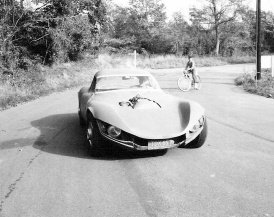 I went ahead with the basics required to pass inspection
and register it. Simple truck clearance lights were used for
directionals and brake lights. Sealed beam headlights were positioned
with the beams aimed as required and temporarily "glued in place". A
small panel made of masonite held the necessary switches and guages and
plain indicator lights. Wiring was run as needed and everything taped
in place on central dash structure. A single blade windshield wiper was
set up and all the required components for inspection were in place. It
was time to test the concept. I put about five hundred miles on the TDX
and then took it off the road to continue finishing it.
I went ahead with the basics required to pass inspection
and register it. Simple truck clearance lights were used for
directionals and brake lights. Sealed beam headlights were positioned
with the beams aimed as required and temporarily "glued in place". A
small panel made of masonite held the necessary switches and guages and
plain indicator lights. Wiring was run as needed and everything taped
in place on central dash structure. A single blade windshield wiper was
set up and all the required components for inspection were in place. It
was time to test the concept. I put about five hundred miles on the TDX
and then took it off the road to continue finishing it.
WHERE HAS THE TDX BEEN AND WHY ISN'T IT FINISHED?
The requirements of business and family responsibilities took
all my time and resources, and the TDX became a non-priority
project. I covered it and parked it in the woods on my
property.
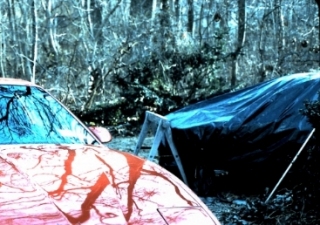 For the next thirty three years, it was exposed to the
salt air from Long Island sound which was only about 500 feet away. It
also had to endure falling branches, layers of leaves and sinking into
the soft soil. It was a home to creatures of the forest that left nests
and even several generations of their brethren. All this worked
together to corrode and destroy much of the metal components while the
fiberglass stayed virtually unharmed. Layers of body filler have flaked
off parts of the TDX surface, but the basic body/chassis is still as
good as it was the day it was made, almost half a century
ago.
For the next thirty three years, it was exposed to the
salt air from Long Island sound which was only about 500 feet away. It
also had to endure falling branches, layers of leaves and sinking into
the soft soil. It was a home to creatures of the forest that left nests
and even several generations of their brethren. All this worked
together to corrode and destroy much of the metal components while the
fiberglass stayed virtually unharmed. Layers of body filler have flaked
off parts of the TDX surface, but the basic body/chassis is still as
good as it was the day it was made, almost half a century
ago.
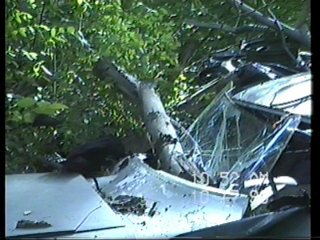 The only casualty was the windshield when the top part of
a tree broke off and fell straight down destroying the windshield, the
horn ring and the top edge of the lower windshield support. The rest of
the structure survived just fine.
The only casualty was the windshield when the top part of
a tree broke off and fell straight down destroying the windshield, the
horn ring and the top edge of the lower windshield support. The rest of
the structure survived just fine.
In 2001 I moved from Long Island and had space to store it
indoors. After about twelve years of indoor storage, it was
brought out in 2013. From it's long stay in the woods and exposure to
the salt air, all the steel suspension and engine components were
covered with a layer of rust while the fiberglass structure remained
virtually unharmed. Some metal components rusted through or
disintegrated. The engine appears to be seized, the exhaust system is
gone from the manifold castings rearward.
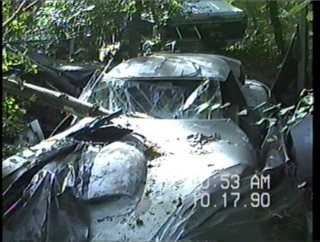
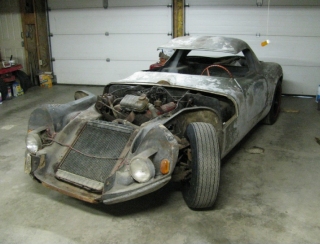
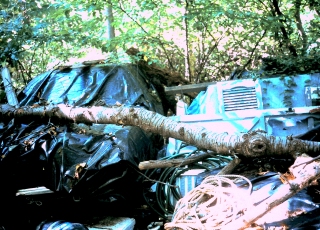
Lots of rust buster lubricants were used to loosen almost
everything that was frozen with rust and corrosion, It was cleaned of
leaves, acorns (some partially eaten) and remains of at least one furry
creature. The paint was mostly gone and my concept of a
super light weight body putty had cracked and lifted away from filled
in areas. The same concept is used in current light weight body putty,
but with more specialized resins. A set of appropriate wheels and new
tires were added. Current plans include, replace the engine
and any other components that are not useable, finish the car as
planned and put it back on the road. It survived thirty three years of
the elements which normally would destroy an all metal car, and after a
total of forty five years waiting, it deserves to be resurrected and
continue to prove that plastics can be used in structural applications.
Everything from fighter planes to race cars make use of structural
reinforced plastics. The TDX used fiberglass, today many other
materials are used. Carbon fiber and Kevlar, are two newer
reinforcements used in applications which were virtually "impossible"
half a century ago.
Return to Plastic Autos Index
 I went ahead with the basics required to pass inspection
and register it. Simple truck clearance lights were used for
directionals and brake lights. Sealed beam headlights were positioned
with the beams aimed as required and temporarily "glued in place". A
small panel made of masonite held the necessary switches and guages and
plain indicator lights. Wiring was run as needed and everything taped
in place on central dash structure. A single blade windshield wiper was
set up and all the required components for inspection were in place. It
was time to test the concept. I put about five hundred miles on the TDX
and then took it off the road to continue finishing it.
I went ahead with the basics required to pass inspection
and register it. Simple truck clearance lights were used for
directionals and brake lights. Sealed beam headlights were positioned
with the beams aimed as required and temporarily "glued in place". A
small panel made of masonite held the necessary switches and guages and
plain indicator lights. Wiring was run as needed and everything taped
in place on central dash structure. A single blade windshield wiper was
set up and all the required components for inspection were in place. It
was time to test the concept. I put about five hundred miles on the TDX
and then took it off the road to continue finishing it.  For the next thirty three years, it was exposed to the
salt air from Long Island sound which was only about 500 feet away. It
also had to endure falling branches, layers of leaves and sinking into
the soft soil. It was a home to creatures of the forest that left nests
and even several generations of their brethren. All this worked
together to corrode and destroy much of the metal components while the
fiberglass stayed virtually unharmed. Layers of body filler have flaked
off parts of the TDX surface, but the basic body/chassis is still as
good as it was the day it was made, almost half a century
ago.
For the next thirty three years, it was exposed to the
salt air from Long Island sound which was only about 500 feet away. It
also had to endure falling branches, layers of leaves and sinking into
the soft soil. It was a home to creatures of the forest that left nests
and even several generations of their brethren. All this worked
together to corrode and destroy much of the metal components while the
fiberglass stayed virtually unharmed. Layers of body filler have flaked
off parts of the TDX surface, but the basic body/chassis is still as
good as it was the day it was made, almost half a century
ago.
 The only casualty was the windshield when the top part of
a tree broke off and fell straight down destroying the windshield, the
horn ring and the top edge of the lower windshield support. The rest of
the structure survived just fine.
The only casualty was the windshield when the top part of
a tree broke off and fell straight down destroying the windshield, the
horn ring and the top edge of the lower windshield support. The rest of
the structure survived just fine. 

